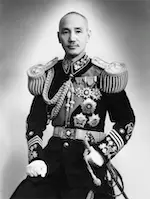Chiang Kai-shek: Leader of China and Taiwan
One of China's most famous military and political leaders was Chiang Kai-shek, who ruled the country for more than two decades and then Taiwan for nearly three decades. He was born on October 31, 1887, in Xikou, in the eastern province of Zehjiang. He grew up in a merchant family and then found his calling in the military, attending training in Japan and then putting that training to work in joining the uprising that resulted in the fall of the Qing Dynasty and the establishment of the Republic of China, in 1911. To help facilitate this, Chiang joined the Kuomintang (KMT), or Chinese Nationalist Party; the founder of that party was Sun Yat-sen. 
Sun favored Chiang and named him head of the Whampoa Military Academy. When Sun died, in 1924, Chiang took over as leader of the KMT. One of Chiang's main points of focus in the first few years of his rule was an internal conflict with members of the Chinese Communist Party. In one well-known incident, Chiang was held hostage by two of his own generals in Xi'an Province, as a way to try to end the internal conflict; his captors released him, after two weeks, after he promised to focus on fighting Japan, not the Chinese Communists. Nevertheless, the internal struggle continued for two decades and took place against the backdrop of a massive Japanese invasion, beginning in Manchuria in 1931 and developing full-scale in 1937. (During this period, Chiang played a major part in safekeeping a handful of priceless artifacts in the Forbidden City.) Chiang and China joined the Allied forces in 1941, when the United States entered the war (after the Japanese bombing of Pearl Harbor). Chinese forces fought against Japanese forces until the end of the war, in 1945. The very next year, a full-blown civil war erupted, between Chiang's government and the Chinese Communists, led by Mao Zedong. After three years of bitter fighting, the Maoist forces were victorious and Chiang fled to Taiwan, taking 2 million people with him. Chiang became the first president of a new Taiwan government. The National Assembly elected and re-elected Chiang president, and he served until his death, in 1975. That entire time, however, the country was under martial law, with Chiang (known as Generalissimo) also still the head of the National Revolutionary Army. In order to maintain the martially imposed peace, Chiang's government prosecuted the White Terror, a system of political suppression. More than once, government troops dispersed demonstrations, most infamously in the February 28 uprising in 1947, in which thousands of civilians were killed. At the same time, Chiang, backed by the United States and other nations, held firm against Chinese incursions into the Taiwan Strait. As well, Chiang's government is credited with introducing land reform and stimulating economic recovery. Chiang had gained an international reputation for his courageous opposition to the Japanese invasion, and he and his government were the official government of China recognized by the United Nations until 1971, when the U.N. switched to recognizing mainland China. Chiang was married four times. His wives were Mao Fumei, Yao yecheng, Chen Jieru, and Soong Mei-ling. He had two sons, Chiang Ching-Kuo (whose mother was Mao Fumei) and Chiang Wei-Kuo (whom Chiang adopted while married to Yao Yecheng). Chiang was born into the Buddhist faith but, after marrying his last wife, converted to Christianity. Chiang Kai-shek died of cardiac failure on April 5, 1975. He was 87. He was mourned for more than a month in Taiwan. His death was marked with much less attention in China. His oldest son succeeded him as leader of the KMT and leader of the country. |
|
Social Studies for Kids
copyright 2002–2024
David White




